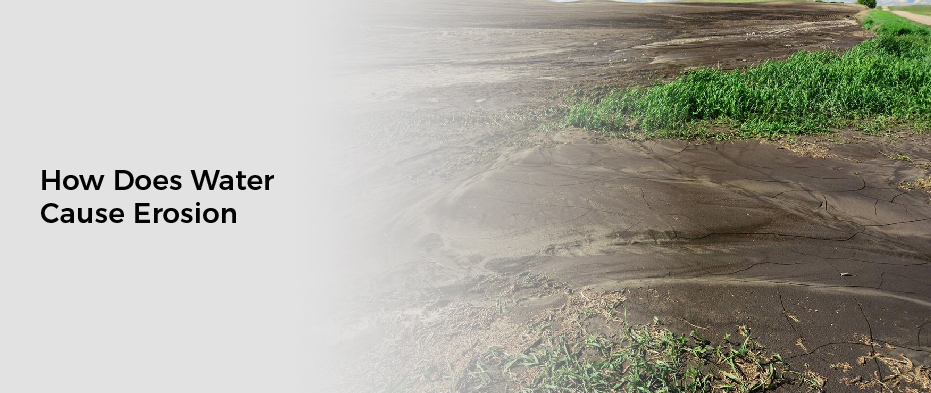Water is one of the most powerful forces on Earth, and its ability to cause erosion has shaped our environment for thousands of years. From carving out mountainsides and canyons to creating winding riverbeds and flooding coastal areas, water’s erosive power molds the land around us. But how exactly does this process work? Today, we will explore what causes water-based erosion and review some common examples that illustrate its destructive — yet often beautiful — impact. So grab your raincoat, and let’s get started!
WATER KEYS:
- Water is composed of two elements: hydrogen and oxygen. When these elements mix, they form H2O (water).
- H2O is a liquid at room temperature but can also be a gas or solid under different circumstances. Water molecules have atomic numbers of 8 (oxygen) and 6 (hydrogen).
What is Water Erosion?
Water erosion is a process by which water flow slowly wears away at soil and rock over time. It can happen in many different ways, but all of them result in the gradual destruction of the land.
Water erosion can take many different forms.It includes sheet flow (where a fast-moving stream carries away large sheets of soil), rill (small streams that carry away sand and silt), channelization (a change in the course or depth of a stream that results in more sediment being carried away), and flooding (where high levels of water cause soil erosion to be washed away).
Causes & Effects Of Water Erosion On The Environment
Water causes erosion because it forms droplets when it hits the soil or rock surface. These droplets are much smaller than raindrops, so they are more likely to evaporate quickly. This leaves a small amount of moisture on the surface that can easily be washed away by rain or irrigation runoff.
Water also has another important property that impacts erosion – its ability to flow downhill. This is why rivers always flow downhill – gravity takes care of the work for you! When water flows over soil or rocks, its tiny particles dislodge bits of material. Over time this will create large chunks that can easily be carried away by runoff or windblown sandstorms.
The effect of water erosion on rocks depends on a few factors, including the type of rock being eroded and the amount of rainfall that has occurred recently. For example, porous limestone will erode much faster than hard granite due to its high absorption rateof rainfallwater. Quickly transporting sediments such as silt and clay through subsurface networks amplifies their impact in many ways. Siege soils subjected to too little organic activity lose their capacity slowly. Thinning forests increase infiltration rates which in turn results in increased sediment loads
When Does Water Erosion Occur?
Water erosion occurs when water flows over a surface and slowly removes the soil and rocks that make up the surface. This process can cause damage to both natural and artificial environments, lead to soil erosion, loss of water supplies, and even the destruction of buildings.
There are many factors that can speed up water erosion. These include rainstorms, floods, snowmelt, and windblown sand. Deforestation, urban development, agricultural practices (such as fertilizing with excessive nitrogen), and salt intrusion (a result of increased sea levels) all contribute to water erosion.
The Process Of Water Erosion
Water erosion is a process that happens worldwide, and it has serious consequences for the environment and human communities. Understanding how water erosion works can help us to reduce its effects and to manage our resources more effectively.
The hydrological cycle is the cycle by which water moves through Earth’s soil, water resources, atmosphere, and biosphere. This cycle plays an important role in water erosion because it determines how water moves from one place to another. In addition, the hydrological cycle influences how much water is available for plants and animals to drink and for humans to use for irrigation or other purposes.
Some factors that lead to increased water erosion include increased rainfall or snowmelt, increased runoff due to deforestation or urbanization, and climate changes. All of these factors increase the amount of sediment and rocks that are carried into rivers and streams. These materials are then deposited along the banks of these waterways, where flowing waters slowly wear them away.
Abrasion is a key process involved in water erosion. Rocks and sediment rubbing against each other create tiny pieces of debris carried away by water flow. This process can cause significant water erosion damage to natural landscapes – not only in terms of aesthetics but also in terms of ecosystem function (such as providing shelter for wildlife).
Ways To Stop Water Erosion
- Plant Grass and Groundcover
A thick layer of grass and groundcover helps reduce the impact of water erosion by Intercepting runoff and protecting the soil from heavy rainfall and other water sources.
- Use Erosion-Control Blankets
These blankets are made of biodegradable materials such as straw, coconut fiber, and wood chips. The blankets help reduce erosion by trapping sediment and slowing water flow over the soil surface.
- Create a Buffer Zone
A buffer zone is an area that lies between an area with potential runoff, such as a hillside or construction site, and the body of water it could affect. This zone can be planted with grass, ground cover, or other vegetation of your choice to intercept runoff, absorb excess water, and trap sediment.
- Install Drainage Swales
These long, linear trenchesare filled with gravel and lined with vegetation such as grasses, shrubs, and trees. They help to capture and absorb runoff and direct it away from areas of concern.
- Build Retaining Walls
Retaining walls can reduce erosion by helping keep water off slopes while also providing structural support for the soil. They should be constructed with durable materials such as concrete, stone, or timber and a proper drainage system.
Signs That You’ve Experienced Water Erosion
If you notice any signs that your property is experiencing water erosion – slight puddles on your driveway after a rainstorm.Or big chunks of dirt popping up along your creek or river – then you should take action right away! Signs indicative of water erosion, such as a rise in property taxes due to property values wiped out by water damage, may occur before any material damage happens to the property or substrate (soil and rock). Before major damage occurs, you can restore the land completely if you take action.
FAQ’s
Unfortunately not always – but there are many things that you can do to help mitigate its effects. For example: avoid building in areas prone to flooding or windblown sand; use flood-resistant building materials; maintain healthy plant life near your home; keep your lawn trimmed; install rain gardens or bioswales; etc. However, prevention is always better than trying to fix problems after they’ve occurred!
There are several factors that contribute to water erosion, including rainfall, snowmelt, runoff, floods, wind, waves, groundwater extraction (such as using machines to pump groundwater out of the ground), and human activity such as construction or farming. Any event that increases the amount or speed of water flowing through a landscape will increase the likelihood of water erosion taking place.
· Flooding due to heavy rainfall or storm surges.
· Overgrazing.· Improper installation or maintenance of infrastructure such as drainage systems or fences.· Agricultural practices such as deforestation or overexploitation of soils.
· Urban development and natural disasters such as hurricanes or typhoons.
Conclusion
In conclusion, we can see many different ways in which water has a hand in causing erosion. Whether it’s via rainy summer storms.Or chiseling through rocks with a whip-like tail stream, windy hurricanes, or underground glaciers growing away – water undeniably impacts the Earth’s surface in myriad ways.
As demonstrated by our understanding of the processes that happen underwater and above ground, this essential element of our planet is responsible for both advancements, as well as erosion of our land. As such, it is important to pay attention to how much and where we use our precious resources.
One small step towards reducing the impact on our planet’s terrain and drainage is to reduce water wastage. And instead re-use existing sources and residues – any little effort may have a bigger impact than you think.


